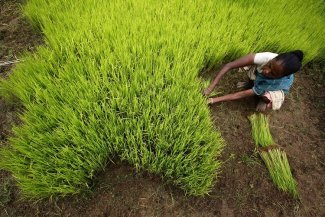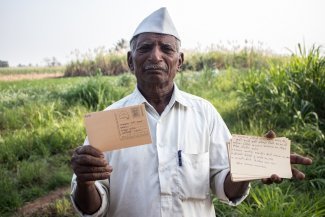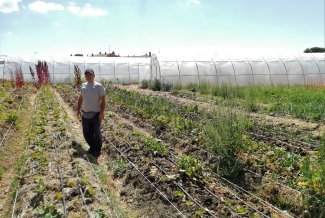A group of women farmers are being trained to make natural pest repellents with neem leaves for their crops in a village in Jharkhand, India on 30 August 2022.
As a child, Gita Devi – a traditional rice farmer from the eastern Indian state of Jharkhand – had not known the use of chemical fertilisers and pesticides to grow crops. Instead, she remembers helping her father prepare manure and pest repellents with readily available natural resources.
“Whatever the farm needed could be obtained from the farm itself,” recalls the 45-year-old living in Rochap, a village in Ramgarh district. But over the years, she observed a change in farming with increased dependence on chemicals to produce more and more.
Like others, she regularly used phosphates and urea in her field. These market-driven chemicals steadily depleted her family’s two-acre farm of its natural nutrients. “The grains lost their original taste and the straw of paddy plants no longer made good fodder for our cattle,” she tells Equal Times.
But over the past decade, the ever-increasing use of chemical inputs has failed to increase crop yields. In addition, Jharkhand has been hit hard by unpredictable climate impacts causing frequent flash floods, erratic and untimely rains, droughts, and extreme temperatures. These factors have made agriculture uncertain and crop failures more common than before, affecting the food security of the rural poor.
With a population of approximately 32 million people, Jharkhand is assessed to be one of the most climate vulnerable states. According a governmental report, Climate Vulnerability Assessment for Adaptation Planning in India Using a Common Framework, the state, along with eight others, requires prioritisation of adaptation interventions.
“Confronted with such uncertainties, the soaring costs of inputs such as seeds, fertilisers, pesticides and labour could not have hit us harder,” rues Gita. Men from the local villages, who have been traditional farmers for generations, have been moving out in search of manual work. This includes Gita’s husband, a daily wage earner who now works in the economic powerhouse of Maharashtra.
But the tide has begun to turn for Gita over the past four years. Not only are her crops much less prone to climate vagaries, but they are also producing a good yield. “The number of tillers shooting out of paddy plants has increased by two-, threefold; the panicles are heavy with more grains,” says a beaming Gita.
This change has been made possible with innovative agricultural practices, using region and climate-specific seeds, less water, replacing chemicals with organic and natural manure, and other climate-friendly techniques. Like Gita, nearly 1,500 farmers across 48 villages in Jharkhand’s Jamtara and Ramgarh districts are gradually taking up this system of farming on over 650 hectares of their land.
It is a part of a climate adaptation project sponsored by the Indian government’s Ministry of Environment, Forest and Climate Change designed to enhance the climate resilience of forests and their dependent communities. The villages involved in the project are located near forest patches that provide dry wood for fuel, wild fruits and vegetables to the local communities.
A paradigm shift
“This had become the need of the hour, considering nature’s growing unpredictability, whims, and fancies. So, our first priority was to make agriculture climate resilient as more than 70 per cent of the state’s population are traditional farmers,” says Sanjeev Kumar, Jharkhand’s additional principal chief conservator of forests.
Kumar, who is also the project officer in charge of formulating the state’s climate adaptation and mitigation plans, admits that convincing farmers has not been easy. “The process demanded a paradigm shift in the mind set of local farmers – from the conventional use of hybrid seeds and chemicals to the use of organic and natural manure,” he says. It was their ingrained belief over the last few decades that chemicals alone could produce a high yield, notwithstanding the frequent crop failures and recurring debts that farmers got trapped into.
The farmers were initially encouraged to try out the process on small patches of their land, explains climate consultant Rajiv Kumar Tiwari, who works for PricewaterhouseCoopers (PwC) India, the consultancy firm charged with facilitating the project. Working with a team of seven experts from PwC and 20 members of the forest divisions of Ramgarh and Jamtara, PwC was engaged by the forest department for its expertise in climate adaptation practices and specialised training.
The project was greenlit in March 2018, work began in January 2019 and will continue until March 2023. Tiwari and his team are currently working with 8,500 rural households, coaching them on various practices that can make the crops robust against climate shocks. The villagers practicing this kind of farming have benefitted economically – both in terms of inputs and yield. And once the project officially ends, there has already been enough mentoring, training and capacity building in order for the work to be sustained and taken forward.
The ultimate aim of the project, says Tiwari, “is to bring awareness and implement various climate resilient strategies to local communities, especially involving the women.”
The farmers are first taught to treat the soil with organic supplements such as cattle manure, planting leguminous plants to reverse the harmful effects of chemicals and enrich the soil with natural nutrients.
Next, is the use of drought-resistant quality seeds instead of conventional hybrid seeds (which must be supplemented with chemicals). The former undergoes a pre-plantation treatment with bio-fertilisers such as fungicides, and organic supplements of nitrogen and phosphate are left overnight.
They are then planted in raised seed beds and allowed to sprout and grow for about 12 days, compared with the conventional duration of about 25 days. Reducing the transplantation age of paddy seedlings, according to Tiwari, helps to develop stronger roots, generate more tillers and maximise grain yield.
These seedlings are then transplanted individually; keeping a distance of seven to eight inches from each other, rather than the bunches of three to four inches use previously. “This is to leave enough space between each plant for optimum intake of sunlight, air, and nutrients from the soil, for healthy growth, with better canopy and stronger roots,” says Tiwari.
Most importantly, the process also requires a fewer number of seeds because in this method, the saplings are transplanted at larger intervals (8-10 inches). If the traditional method required 10 kilos of hybrid seeds per acre, the new system covers the same area with three kilos of hybrid seeds. This also means less labour in the field, which contributes to reducing the total cost of production by between 30 and 35 per cent of the earlier cost of 7,500 rupees (approximately €84.90) per acre.
“Another significant advantage of this kind of farming,” says Kumar, “is that unlike traditional paddy cultivation, it does not require stagnant pools of water in the fields.”
According to him, it is enough to keep the soil moist and not flooded, as the roots tend to wilt otherwise. This reduces the requirement for water by nearly 40 per cent and, most importantly, cuts down the emission of methane gases by 22 kilograms per hectare. Methanogens, or the bacteria that generate methane (which cause nearly 28 times more global warming than carbon dioxide) can only thrive in submerged paddy fields, he explains. This kind of farming has reduced the emission of methane by 14.3 tonnes across 650 hectares.
Homemade soil and crop treatment methods
The importance of such regenerative agricultural practices and nature-based solutions to enhance food security was recognised in the recent global climate meeting, COP27, in ascertaining countries’ nationally determined contributions and national adaptation plans. Further, in the European Union, a new World Economic Forum report on farmer-first climate strategies found that greenhouse gas emissions could be lowered immediately by 6 per cent a year if just one-fifth of EU farmers were supported with climate friendly agricultural practices, which could boost soil health and farmers’ incomes by between €1.9 and €9.3 billion annually by 2030.
Meanwhile, the key to the success of such low-carbon farming is using manure and pesticides prepared from natural sources. “Most families keep cows at home, so we advocated the use of cow dung and urine as one of the major constituents,” says Tiwari. The farmers were taught other formulations using live forest soil, neem leaves, guava, papaya, custard apple, fermented buttermilk, chilli, and garlic, among other natural products, which are mixed in varying proportions and used for about 105 days until the paddy matures.
Gita is excited to return to these homemade soil and crop treatment recipes. “If I was previously required to spend between 1,800 rupees (approximately €20.37) and 2,000 rupees (approximately €22.64) per acre on chemical inputs earlier, now it’s reduced to about 500 rupees (approximately €5.66) to 600 rupees (approximately €6.79),” she says.
From her production of about 1.5 to 1.6 tonnes per acre earlier, now it is over 2 tonnes. With this, there is enough for her family’s consumption. She can also keep aside 10-12 quintals of paddy for sale per season (1 quintal = 100 kilograms).
All of these measures put together are fetching a net income of about 10,000 rupees (approximately €113.19) to 12,000 rupees (approximately €135.85) per season compared to uncertain returns in the past. Encouraged by the results, her family is keen to scale up this form of cropping and even try out multi-cropping too.
However, Kumar points out that the system has its share of challenges, too, in requiring specific expertise and training for the farmers, which are not always readily available. To overcome this, the trained farmers are being deployed to impart similar skills to fellow farmers. Gita, for instance, heads a women’s self-help group of about 300 women, who have imparted training to about 40 families.
But today, what pleases Gita most is to see her field come alive with natural biodiversity. “The soil had become dead with the continued use of chemicals. But today, the same field is teeming with hopping and chirping birds, various butterflies, and insects,” she says.













